RK-47 Capsules

Mic-Parts RK-47
Thursday, August 8, 2013

I have a predilection for the AKG edge terminated capsules over center terminated Neumann style ones. It seems obvious to me that the most sensitive part of a diaphragm where motion is naturally greatest is the center. Screwing that down to the backplate so the diaphragm has to vibrate as a donut seems counter-intuitive. Still, it’s hard to argue with the results Georg Neumann and his crew have gotten. I’m also opposed to the deliberate introduction of resonances within the audio band, as in the U-87 and U-67 family of capsules. There are places where that sound is exactly what’s needed, but for me that’s a specific sound usually reserved for something that has to cut through a mix, not a sound that I want on everything.
There is a center-terminated Neumann capsule that doesn’t have that high end resonance - the K47, and based on user reports, I decided to try a pair of Mic-Parts RK-47 clone capsules. Instead of yet another pair of modified MXL 990 bodies, I used the bodies of the Chinese karaoke mics discussed in the previous post.
The RK-47 capsule pops right into the silicone rubber shock mount inside the headbasket. A hole is drilled in the conical basket support to hold a SPST switch for selecting cardioid or omni pattern, and a big hole is chewed out in the middle of the inner mounting plate to allow the switch to poke through for wiring access.
Wherein the bones of the cheap China mic are fleshed out with RK-47 capsules from Microphone-Parts.com and Schoeps-style impedance converter electronics.
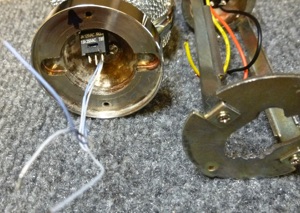
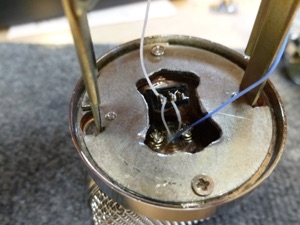
I decided to base the impedance converter electronics on the existing printed circuit board as much as possible, with a separate capsule bias DC-DC converter on a bit of proto-board.
I removed the first two stages of the original electronics and cleaned up the PCB, then scrounged around in the parts bins to come up with a workable Schoeps style circuit.
The output stage emitter followers were left intact, but everything else got modified or replaced.
A J305 FET is tacked to the board by its source and drain leads with the gate up in the air. The lead from the pattern switch and the 1 GΩ resistor tie to it in mid air. The source and drain resistors are tacked to appropriate points on the PCB or space tie points of their own.


The capsule bias DC-DC converter is a tiny Hartley oscillator built on a postage stamp piece of perf-board. It is adjustable from about 40 to 85 volts.
Some day I’ll investigate the effect of varying voltage on the capsule. For now, it’s set at just under 70V.
So here’s the circuit as it exists after a few tweaks.

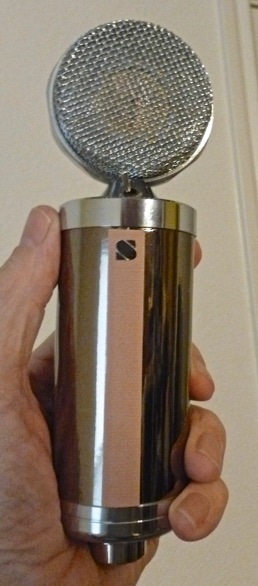
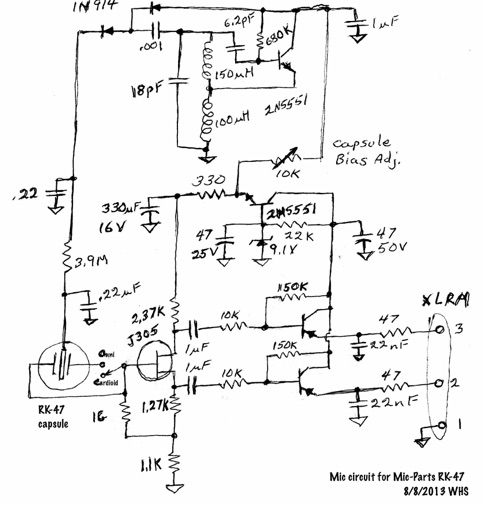
Second harmonic dominates distortion at levels approaching 0 dBV, more than 80dB down.
Blue = noise & distortion @ 1KHz, .4V output. Yellow = 1KHz at -20 dBV. Green = preamp noise.
At normal mic levels, distortion is unmeasurable.
A nice neutral pair of mics. Very natural sound character, with a very slight emphasis in the upper mids centered around 4KHz, and a gradually falling top end above 11 KHz. No zip or extra air, but not dark sounding, either. Quiet with excellent S/N and extended LF response. These should be useful for all sorts of instruments and ensembles. They are high performance mics of the same calibre as the high price German brands. Pro quality studio mics can be built on a modest budget from readily available parts.

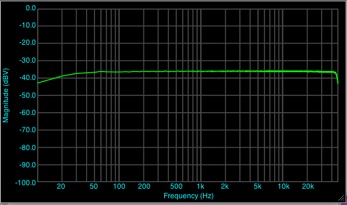

How does the circuit perform? Here are electronic measurements. Acoustic measurements to come.
Clipping is at 5V P/P and frequency response is flat from 50 - 50KHz, -3dB at 20Hz.

